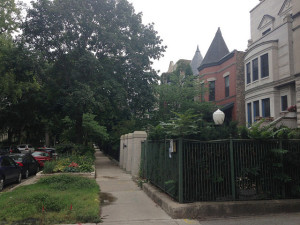The corporate headquarters used to be the primary measure of a city's economic clout. Saskia Sassen, while not ignoring headquarters, documented how in the age of globalization, the resurgence of the global city was driven by demand for financial and producer services, not more and bigger HQs. As she pointed out in her seminal book The Global City, "Major cities such as London, New York, and Chicago have been losing top ranked headquarters for at least three decades." Yet despite this they were coming back strong. Back in 2008, I started … [Read more...]
A Riverfront Revelation in Chicago
The image we have of Chicago in our minds is heavily shaped by its lakefront. The importance of the lakefront as public space was recognized long ago when the city built its magnificent lakefront park system, choosing to largely turn its back on industrializing the lake. Chicago was heavily industrialized, however, But the main "harbors" along which this was done were the Chicago and Calumet Rivers. The Chicago River heavily shaped the history of the city and do this day defines the boundaries of the Loop business district. Yet the city … [Read more...]
When High Density Is Humane, Chicago Edition
Kenmore Ave. looking south from BeldenAs a follow-up to my piece on the humane density of New York's Upper West Side, I was in Chicago last weekend and took some snaps of the same effect in that city share with you. These pictures are of Lincoln Park, a North Side neighborhood that is among the city's most prestigious. It's about three square miles, extending from the lakefront park of the same name west to around Clybourn Ave. The density is 20,000 per square mile. This is far lower than the Upper West Side, but the comparison is not quite … [Read more...]
The Three Generations of Black Mayors in America
[ This week is the Thanksgiving holiday in the US, so I'll be away and enjoying it for the rest of the week. As a holiday long read for you, I'm posting this very important piece about the three generations of black mayors in America and how the timing of the election of the first black mayor affected the trajectory of those cities, with implications even today. Pete is the best writer on urbanism and race that I know and you can read his writings about this and more on his site Corner Side Yard - Aaron. ] The Monument to Joe Louis, … [Read more...]
Chicago’s Secondary Stations: Little Engines That Could…And Should
This is part of the series North America's Train Stations: What Makes Them Sustainable or Not? To describe how central stations can help us evolve toward sustainable transportation, this series uses a middle category called “Economic Engines.” This category stimulates its surrounds. These three Chicago stations do that job well. Category: Economic Engines (click for all currently reviewed stations) Consolidated Scorecard: Click to view full scorecard Scorecard Summary: max pnts = 100 80 Ogilvie Transportation Center … [Read more...]
More On the Midwest vs. the South
My post on Sunday about SEC vs. Big 10 football produced quite a stir. There are 165 comments and counting, and it even prompted posts by Richard Longworth and Crain's Cleveland Business. Not everyone was critical but the ones that were basically say that it's ludicrous to say that football proves anything. I don't think that it does. But I will make three points: 1. The differing fortunes of the two conference is yet another in an extremely long series of data points and episodes that demonstrate a shift in demographic, economic, and … [Read more...]
Are States an Anachronism?
This post originally appeared on July 11, 2011. Obviously states aren't going anywhere anytime soon, but a number of folks have suggested that state's aren't just obsolete, they are downright pernicious in their effects on local economies. One principal exponent of this point of view is Richard Longworth, who has written about it extensively in his book "Caught in the Middle" and elsewhere. Here's what he has to say on the topic: In the global era, states are simply too weak and too divided to provide for the welfare of their … [Read more...]
The Mayor As Entrepreneur-in-Chief
[ Ramsin Canon is one of the most keen left political observers I know in Chicago. Among other things he's been the politics editor at Gapers Blocks, a union organizer, and is now a law student I believe. Needless to say, he's no fan of "neoliberalism", even when practiced by those on the left. Here he provides his frame and critique of the current reigning governance model in our various levels of government re:cities. I may revisit this topic with my own thoughts in the future, but I'd like to make a couple of observations here. 1) Canon sees … [Read more...]
Chicago Union Station
This post is part of a series called North America’s Train Stations: What Makes Them Sustainable — or Not? See the series introduction for more. The photo above is how I used to think of Union Station: the architecturally famous Great Hall. But as the nation’s third largest station, I always wondered why so few people were in it. Before I share the answer, please allow this summary background. Score: 61 (see full scorecard) Category: Inexcusable This series’ previous post analyzed Philadelphia’s Center City stations as representing … [Read more...]
The Growing Public Safety Inequality Gap in Chicago
[ Daniel Hertz writes over at his City Notes blog. He was gracious enough to give me to permission to repost the results of his research into changes in crime patterns in Chicago over time - Aaron. ] Here are two maps: HOMICIDE RATE BY POLICE DISTRICT 1990-1993 2008-2011 Like the captions say, the one on the left shows homicide rates by police district in the early 90s, when crime was at its peak in Chicago, and the one on the right shows the same thing, but about two decades later.* The areas in dark green are the … [Read more...]
- « Previous Page
- 1
- 2
- 3
- 4
- …
- 6
- Next Page »






